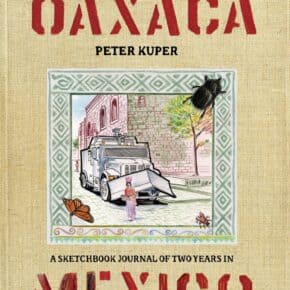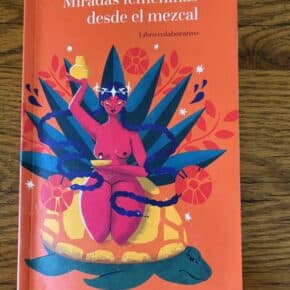This week we are re-publishing a trio of posts from the brilliant Cristina Potters at Mexico Cooks! about pulque, mezcal, and what Michoacan brings to the table. We started with pulque on Wednesday, moved to a mezcal guide on Friday, and we wrap up with today’s post on a very special Michoacan mezcal.
Michoacan is seeing renewed interest since its mezcal became officially recognized. Recently, we’ve tasted quite a few from mezcal afficianados who have toted bottles home in their luggage. We look forward to seeing some on specialty liquor store shelves soon. You can find the original version of this post here.
—
Michoacán Mezcal Uasïsï, Brought to You By Mayahuel–The Goddess of Maguey
When you read last week’s article, Mexico Cooks! had just boarded a guajolotero (often called ‘chicken bus’, in English slang) to go with friends to meet a mezcal producer in Michoacán. I also left you with homework, class: did you read the article linked here? Give it a once-over, if you didn’t already, and then let’s get going down the road. Click on any photo to enlarge it for a better look. Photos by Mexico Cooks! unless otherwise noted.
Close to the northern edge of the Tierra Caliente, outside Etúcuaro, Michoacán, there’s a well-hidden vinata (mezcal-making setup)–it’s just beyond this field of agave cupreata. To get there, you need to go with someone who knows how to find it. The mezcal producer, Ignacio Pérez Scott, is the fourth generation of his family to dedicate himself to production of the liquor. He produces traditional mezcal which he then sells to select bottlers for branding. We’re visiting the vinata with Maira Malo Hernández, owner of the mezcal brand Uasïsï (wah-SHEE-shee), and her daughters, Viridiana and Mayra Méndez Malo. Sra. Malo’s daughters and her sons, Juan, Carlos, and Jorge Méndez Malo are also part of the Uasïsï team.
In the shade of the vinata, mezcal producer Ignacio Pérez Scott shares an affectionate moment with Maira Malo Hernández.
Uasïsï, the name Sra. Malo chose for her mezcal, is the Purépecha word for bat. It’s this bat that pollinates thecupreata maguey, among other magueys.
Don Nacho (“don” is an honorific title, used with great respect, and “Nacho” is the Mexican nickname for Ignacio) told me that his cupreata maguey (seen here with its spike of yellow quiote–the maguey flower) takes eight to ten years to mature. Once it matures and throws up the flower spike, the plant can be harvested.
When the producer harvests the maguey plant, the first task is to remove the quiote (flower stem); the pencas (leaves) are removed next. The pencas were removed from the places where you can see the diamond shapes on the outside of the hearts. The pencas can be used in cooking, particularly in making traditional barbacoa and mixiote. The corazón (heart) also known as piña (pineapple) of each maguey plant is then chopped into smaller pieces for baking. In the photo above, Mezcal Uasïsï owner Maira Malo Hernández pitched in to chop some of the piñas. Photo courtesy Uasïsï MMH (Maira Malo Hernández).
Here you can see the size of the chopped piñas de maguey. Each piña can weigh as much as 80 to 100 pounds. Photo courtesy Uasïsï MMH.
Pine logs, stacked firmly into the fire pit. Photo courtesy Uasïsï MMH.
Don Nacho is tamping the volcanic rock evenly into the pit, on top of the pine logs. Photo courtesy Uasïsï MMH.
The fire in the pit is red hot and smoking. Photo courtesy Uasïsï MMH.
The fire is burning evenly now, and the piñas are ready to be placed in the baking pit. The pit will be loaded with approximately 150 piñas weighing a total of about four tons. Photo courtesy Uasïsï MMH.
The burning pit is covered with petates (woven reed mats) and then with mounded earth. The piñas need to bake for a full week. Photo courtesy Uasïsï MMH.
After a week, the piñas are thoroughly baked and are now uncovered. At the bottom right-hand corner of the photo, you can see some petates (woven reed mats). Photo courtesy Uasïsï MMH.
The more than six foot long pine-lined trench where the baked piñas are hand-chopped and smashed with axes.
The vinata crew has moved some of the baked piñas to the trough and are hand-smashing them with axes so that they can be placed into the fermenting tanks. Don Nacho and his crew use no machinery during any stage of their mezcal production. Photo courtesy Uasïsï MMH.
These are the tinacos (covered storage tanks) where the baked and smashed piñas are fermented. The fermentation process takes a week.
Post-fermentation, the process of double-distillation begins. This is the alambique (still), made of pine. As the mezcal distills, the metal top allows condensation to drip back into the still.
The other side of the alambique. Don Nacho explained that the wooden still will last for about one year; after that, the wood will be replaced.
This is the fire hole, where a pine wood fire actually cooks the fermented maguey piña mash to distill it. Above the metal arch of this fire hole are several inches of concrete, the top of which you can see in the photo just before this one. No fire actually touches the wooden still.
The finished product: Uasïsï Mezcal Joven. Photo courtesy Uasïsï MMH.
Both sides of the bottle. The front label, on the right, tells you that this is joven (young, unaged) mezcal with 48% alcohol content. The back label, on the left, gives all the pertinent information about the mezcal: the number and lot of the bottle, the exact provenance (village or state) of the mezcal, as well as the type of maguey used. Photo courtesy Uasïsï MMH.
Tamarind or pear flavored mezcal Uasïsï: made slightly sweet with real fruit, it’s perfect for dessert. Photo courtesy Uasïsï MMH.
This Uasïsï tasting was held at UNLA (Universidad Latina de América) in Morelia, Michoacán.
And what, you ask, does Uasïsï joven actually taste like? To start with, if you have tasted other mezcales, you probably and immediately think smokey. Uasïsï is not in any way smokey. To my palate, Uasïsï joven tastes fresh, like the green of the maguey. It has slight lingering tones of Michoacán pine. It carries a hint of flowers. Because the alcohol content is high, the first sip feels strong in the front of the mouth. As it moves to the back of the tongue, it mellows. And the moment you swallow that first drop, filled with the flavors of Michoacán, you immediately want another. Uasïsï is an extraordinary drink, destined to be a star in the world of mezcal.
Now that you know you want a bottle (or two or three–don’t forget about the tamarind dessert mezcal) of Uasïsï mezcal, where can you get it? The Uasïsï home base is Mex*Calli Mezcalería, Buenavista #5, Pátzcuaro, Michoacán.
Otherwise, my good friend Maira Malo Hernández and I (pictured at Morelia en Boca 2014 with Mexico City chef and chocolatier Luis Robledo Richards) invite you to buy Uasïsï at:
- Itacate Morelia
Blvd. Juan Pablo II #315
Morelia, Michoacán - Agua y Sal Cebichería
Campos Elíseos #199-A
Col. Polanco, México D.F. - La Catrina Comedor & Mezcalería
Av. 5 de Mayo #661
Zamora, Michoacán
It’s entirely possible that Uasïsï mezcal will be coming soon to a liquor store near you. Check back with Mexico Cooks!from time to time and we’ll keep you up to date on the possibility of export to countries outside Mexico. And if you’re planning to be in Mexico and would like to visit thevinata, Mexico Cooks! can make that dream come true. The experience is magical.













Leave a Comment